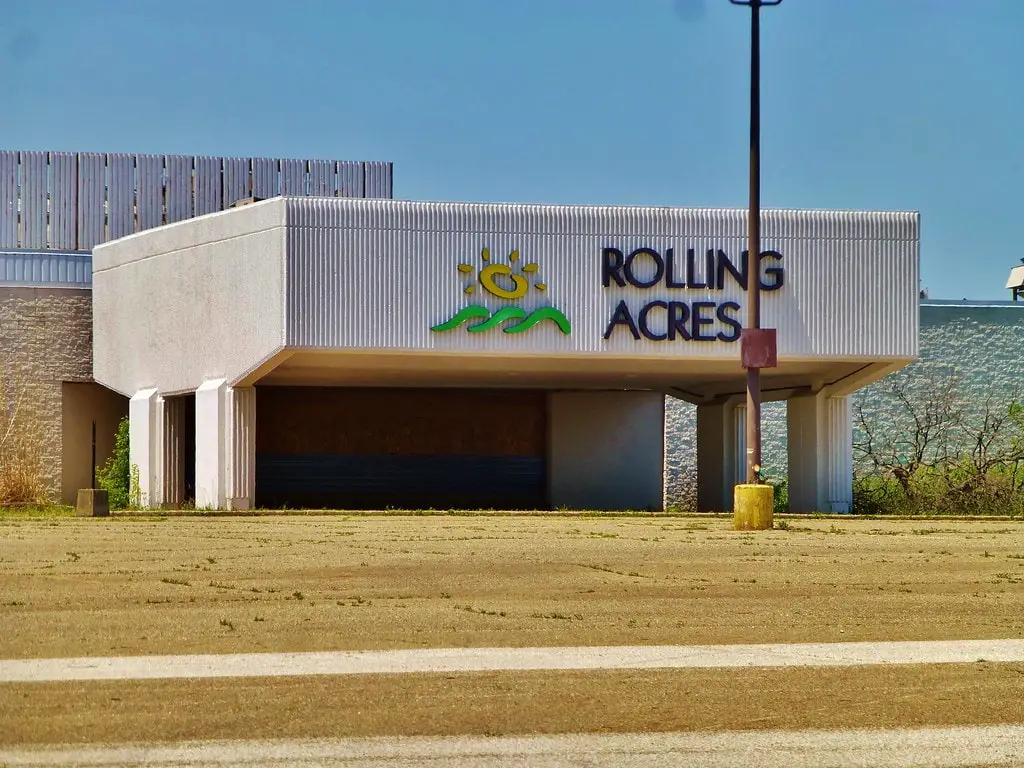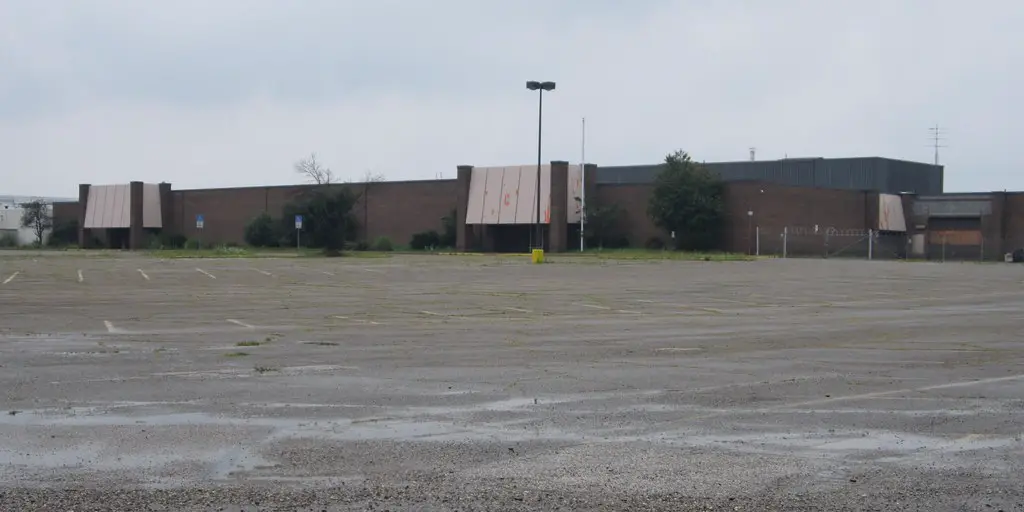The Birth of Rolling Acres Mall
In 1975, the city of Akron, Ohio, welcomed a new addition that would soon become a cornerstone of the community—Rolling Acres Mall.
The mall was more than just a shopping center; it symbolized economic prosperity and a gathering place for families.
With its grand opening, the mall brought a sense of excitement and anticipation, as it was home to various retailers that were new to the area.
The mall’s initial lineup of stores was impressive, featuring famous names like Sears and JCPenney. These anchor stores were complemented by a range of smaller shops, offering everything from fashion to electronics.
The mall was not just a place to shop but a place to experience. With its indoor fountains and lush greenery, the mall’s aesthetic appeal was as much a draw as its retail offerings.
During its early years, Rolling Acres Mall became the go-to destination for holiday shopping, weekend outings, and special occasions.
The mall also hosted community events, turning its spacious corridors into more than just pathways between stores. It was a space where people came together, where memories were made.
However, even in its infancy, the mall faced challenges. The economic landscape of Akron was changing, and while the mall was a symbol of prosperity, it was also a sign of the struggles that lay ahead.
The steel industry, once the backbone of Ohio‘s economy, was in decline, and the city would need to adapt to survive.
The Golden Years
Fast forward to the late 1980s and early 1990s, and Rolling Acres Mall was in its heyday. The mall expanded, adding more retail spaces and a food court.
It was the place to be, especially for the younger generation. Teens would flock to the mall on weekends, making it a social hub as much as a shopping center.
During this period, the mall was almost always bustling with activity. Seasonal events, like holiday sales and back-to-school promotions, drew massive crowds.
USA Quiz
How many questions would you like?
The mall even hosted concerts and car shows, making it a versatile space that catered to a wide range of interests. It was more than just a collection of stores; it was a cultural landmark.
However, this period of prosperity did not last. As the 1990s progressed, the mall began to show signs of wear and tear.
Maintenance was deferred, and Dillard’s and JCPenney, two anchor stores, were downgraded to the outlets. The once vibrant atmosphere began to wane, and the mall’s foot traffic declined.
Despite these challenges, the mall remained a significant part of Akron’s landscape. It was still a place where people could unite, even if those gatherings became less frequent.
The mall had become a fixture in the community, but it was clear that it would need to evolve to stay relevant.
The Decline
The 2000s marked a turning point for Rolling Acres Mall, but not in the way anyone had hoped.
The mall faced increasing competition from newer shopping centers and online retailers. As a result, more stores began to close, leaving empty storefronts and a sense of desolation.
Adding to the mall’s woes were incidents of vandalism and blight. The once pristine corridors became littered with graffiti and broken fixtures.
Security became a concern, and the mall’s reputation suffered. Families who once saw the mall as a safe and enjoyable place to spend their weekends began to stay away.

Attempts were made to revitalize the mall, including plans for redevelopment and attracting new tenants. However, these efforts were largely unsuccessful.
The mall’s decline seemed irreversible, and it became a symbol of economic downturn and failed commercial ventures.
By 2017, the mall had reached the end of the line. It was razed, leaving a vast space and a community to wonder what could fill the void.
The mall had been a part of Akron’s identity for over four decades, and its loss was felt deeply.
The Amazon Transformation
In a twist of fate, 2020 brought new life to the site of the former Rolling Acres Mall. Amazon’s online retail giant announced plans to build a 640,000-square-foot fulfillment center on the mall’s vacant land.
The news was met with mixed reactions. While some mourned the loss of the mall, others saw this as a sign of progress and economic recovery.
The construction of the Amazon fulfillment center provided hundreds of jobs, giving a much-needed boost to Akron’s economy.
The facility became operational on November 1, 2020, and has since become a hub of activity, albeit different from the mall. The center focuses on logistics and delivery, making it a crucial part of Amazon’s supply chain.

While the Amazon facility doesn’t offer the same communal spaces or retail variety that the mall once did, it serves a practical purpose.
It’s a sign that Akron is adapting to the changing economic landscape, embracing new opportunities while acknowledging its past.
The transformation from a bustling mall to a functional fulfillment center is a testament to the resilience and adaptability of Akron and its people.
It’s a story of endings and new beginnings, a narrative that reflects the broader economic shifts that have shaped communities across America.
The Mall in Popular Culture
Rolling Acres Mall has not been forgotten; it lives on in the collective memory of Akron’s residents and beyond.
In the years following the demolition, several videos have appeared on YouTube, offering viewers a glimpse into the past and current state of the mall.
The mall has also been the subject of various articles and social media posts, often accompanied by nostalgic photos and stories from those who remember its better days.
It is a poignant reminder of a bygone era when malls were social and retail activity epicenters.

While the mall may no longer exist in its original form, its impact on the community is indelible. It has become a symbol of the challenges and opportunities of economic change.
Its story is a lesson in adaptability, a case study of how communities can evolve without losing sight of their past.
In many ways, the story of Rolling Acres Mall is the story of Akron itself—a city that has faced hardships but continues to find ways to adapt and thrive.
The mall may be gone, but it is far from forgotten. It remains a part of Akron’s cultural and economic landscape, a landmark in the truest sense.
Community Reactions and Future Prospects
For those who grew up visiting Rolling Acres Mall, its transformation into an Amazon fulfillment center has been met with a mix of nostalgia and pragmatism.
Many residents have fond memories of time spent at the mall, and its loss is felt keenly. Yet there is also an understanding that change is inevitable, and many are optimistic about what the Amazon facility means for Akron’s future.
Comments from residents reveal a sense of loss and recognition of the need for progress. While the mall was a significant part of their lives, many acknowledge that its decline was a sign of changing times. The Amazon facility, they hope, will bring new opportunities.

Ultimately, the story of Rolling Acres Mall is one of transformation. It mirrors the broader changes in Akron and, by extension, American retail and community spaces.
It’s a story that continues to unfold, shaping and being shaped by the people who call Akron home.
Conclusion
The tale of Rolling Acres Mall is one of highs and lows, encapsulating the complexities of economic change and community development. While the mall may be a thing of the past, its legacy lives on.
It serves as a reminder of the importance of adaptability and resilience. As the city looks to the future, the story of Rolling Acres Mall remains a significant chapter in its ongoing narrative.
The mall’s journey—from a place of community gathering to a symbol of economic challenges and finally to a functional, job-creating facility—offers valuable insights into the ever-changing landscape of American retail and community spaces.
It’s a story that holds lessons for us all as we navigate the complexities of a world in constant flux.




Hi Spencer, I helped build the mall and also worked there. I saw first hand the real decline of the mall. When the bus lines started dumping off large groups of unsupervised, loud, violent teens, who assaulted shoppers and robbed them in the parking lots, that was the beginning of the end. Instead of addressing the issue with increased security, management tried to cover it up. People grew aware and stayed away for the place.
Thank you for sharing your firsthand experience with Rolling Acres Mall. I appreciate your honesty. Your experience provides a cautionary story for other malls and public spaces.